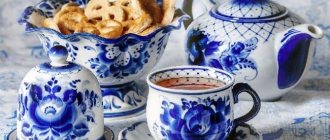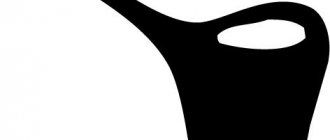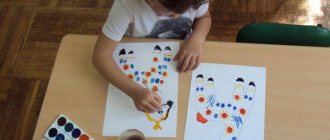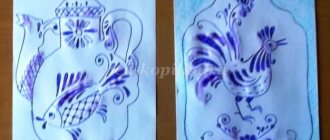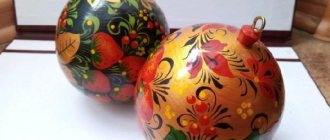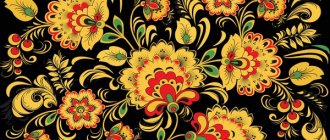History of origin
Gorodets painting originated in the 18th-19th centuries in the Nizhny Novgorod region. There were many talented woodcarvers here, whose products decorated the life and household utensils of the peasants. Fairs with wooden products were famous in this area.
According to history, earlier in every village they celebrated the day of Ivan Kupala and, in addition to mass celebrations and lighting bonfires, they looked for an unusual fern flower. It grew in the forest and bloomed only 1 night a year - on Ivan Kupala. Residents did not know what it really was and therefore endowed it with an individual shade.
Later, Nizhny Novgorod craftsmen decorated wood products with amazing fern flowers. Some were bright red, others were sunny, and some were black. They were called kupavs with fern leaves. It was believed that such a symbol would bring prosperity and happiness to the house.
Also in those days, every house had a dismountable spinning wheel. After working on it, the bottom on which the comb was attached was hung on the wall. To attract attention, they began to decorate it with paintings. When fabrics became cheaper, the spinning wheels were hidden, and master carvers, in addition to the bottoms, began to decorate other utensils, including dishes, furniture, and children's toys with strange images.
Features of the painting
At first, craftsmen decorated the bottom with carved images. Then the inlay appeared - a mosaic of pieces of darkened oak that fell into the flooding river and lay there for a long time. Large elements of the design were made from these pieces, and small ones were executed with a chisel. At the same time, the technique of Gorodets painting on boards began to emerge - the convention, schematic writing of animals, people, objects and plants. Gradually, drawn scenes and coloring join the carvings. The composition becomes richer and more complex. Tiered paintings appear - each tier has its own plot, on which various details of the image stand out.
In 1870, the icon painter Ogurechnikov came to the village of Kurtsevo to update the painting of the local church. He reveals to village craftsmen the techniques of icon painting - layering of paint, enlivening with white. And master carvers become artists. Products are created using icon painting technique. Gorodets work developed rapidly. Craftsmen took on any job, painted furniture, panels, and children's rocking chairs. After World War II, the fishery completely disappeared. It was revived again in the sixties. Artists decorated cutting boards, boxes, nesting dolls, and dishes.
Drawing tools
True masters say that the most important thing in their work is their state of mind. It must be pure, enlightened. It is necessary to fully concentrate on the artistic work that lies ahead in the next few minutes.
A modern person, accustomed to the fast pace of life, even with the greatest desire, cannot for a short time renounce everyday worldly worries and problems, as skillful icon painters who lived several centuries ago did. However, focusing on creativity must be learned.
You should start with organizing your workplace, paying attention to the following aspects:
| Aspect | Description |
| Table | Gorodets craftsmen differ from Khokhloma and Bogorodsk craftsmen in that during their work they can sit at ordinary tables. The working surface does not have to be located at the level of the seated person’s knees. Khokhloma and Bogorodsk masters should have long tables, but Gorodets artists work on tables of ordinary length. Beginner creators are advised to ensure that the table is wider, preferably with a footrest |
| Chair | The chair on which the artist will sit should be positioned so that the rays of light are on the left side |
| Lighting | It is better to give preference to natural light. To do this, you can sit near a window where the sun is shining. If this is not possible, you can use a lighting device. The lamp should be bright and located so that the canvas on which it is planned to paint is evenly illuminated. All areas of this canvas should receive approximately the same amount of light. Only in this case will the light emitted by the device be close to natural light |
| Room | One of the main conditions is that the work area must be well ventilated. Failure to comply with this requirement may lead to an allergic reaction as a result of prolonged interaction with paints, varnishes, solvents and other chemicals that are not very beneficial to health. |
To avoid excessive stress during the process, experts recommend that you immediately get used to the working position.
To do this, the artist needs:
- be positioned straight;
- tilt your head a little;
- make sure that the distance between the eyes and the canvas is just over 30 cm;
- During the process, draw with both the brush and the entire upper limb, starting from the forearm.
Sometimes the artist holds his hands suspended: with his left he supports the wooden product, and with his right he directly carries out the painting itself. Sometimes the master's forearms rest on the surface of the table. This happens, for example, when painting a flat plate.
Before starting work, it is necessary to correctly place on the table surface all the equipment that you plan to use. If this is not done, then fuss will begin during work. For this reason, real masters follow a strictly routine order in placing paints and painting tools on the table.
Namely:
- The place in front of the master is free. Items that will be needed in the work will be placed here;
- it is necessary to allocate a space of approximately 0.5 square meters. m to accommodate 2-3 small boards. They should lie so as not to interfere with each other. Next time, the master can replace the boards with wooden spoons or boxes that are to be painted;
- Place containers with paints and a palette near the products. The latter is a wide plate of glass or plastic. The main condition is that its surface should be easy to clean;
- Place a vessel with water on the table and put a small cloth.
For a beginning craftsman, the main tools will be brushes, paper and paints.
Paper
You will need white paper. You can take a leaf from a school album.
Paints
Gorodets masters perform painting elements with oil paints, so you can follow their example. However, a novice painting artist is recommended to use gouache. This could be a kit for schoolchildren.
Black, white, scarlet, cherry and bright blue are used pure, and yellow, dark green and red are used to obtain new colors. If you mix them correctly, you get a gamma similar to Gorodets.
You will also need cinnabar to work. This is a material that has a bright red color. It is expensive, so many beginning artists do without it at first. However, without cinnabar it will not be possible to make a good painting.
An artist working with gouache must remember: before starting to apply the 2nd layer, you must wait until the previously applied layer has completely dried. If this is not done, the image will take on a whitish tint.
Brushes
Craftsmen use various brushes to apply paint to a wooden product. Their exact number and size depend on what techniques will be used, as well as on the scale of the work. Artists can work for several days to create one masterpiece.
All brushes must be placed on special wooden stands.
Gorodets painting (elements of painting are done without a layout) will require 3 artistic brushes:
- squirrel under No. 2 or No. 3;
- core under No. 1 or No. 2;
- flute made of soft hair.
After use, each brush should be thoroughly washed and dried.
Basic colors of Gorodets painting
Gorodishche artists first used egg-based paints, then oil, tempera and gouache. At first, the surface of the products was primed; after the war, paints began to be applied directly to the surface, which made painting lighter, more vibrant, and transparent. Now modern acrylic paints have begun to be used.
- Painting - ocher, pink, red, burgundy, blue, blue are used to paint flowers and berries. For leaves – green, sometimes brown;
- Shade - blue and light blue details are shaded with dark blue, black and brown tones.
- Razzhivka - painting is done in black and white (ozhivka), occasionally yellow on leaves and flowers.
Painting in the modern world
At the beginning of the twentieth century, the Gorodets fishery practically ceased to exist. Wars, revolutions, collectivization and universal entry into collective farms significantly reduced the number of male master artists. But as soon as life began to improve, women took up writing. In the thirties, the first workshops arose, in the fifties - an artel of painters who preserved the best traditions of Gorodets writing. In 1960, the Gorodets Painting factory opened in Gorodets. Now famous craftsmen work at the factory and are training their successors.
Elements and motifs of Gorodets painting
The style of Gorodets writing has a special intensity. First of all, these are genre everyday scenes. They are conventional and decorative. This is a realistic-fairy-tale plot, in which ordinary scenes are performed using grotesque techniques - elaborate fashionable costumes, idealized animals and firebirds. Luxurious lush roses, roses and daisies, painted elegantly and lushly, a common style in painting. Less common are exotic motifs - figures of lions, deer and leopards, a rooster in a grotesque pose, a strong, beautiful horse in a fairy tale style. Heraldry – paired images, arranged symmetrically. The plot is often framed by a curtain with an elegant cord, inflorescences and bouquets. The background is usually green, sometimes red cinnabar, black, emphasizing the fiery multicolor of the painting.
Elements
Floral structures prevail in the painting:
- Bouquet – symmetrical images of flowers with leaves receding. Large ones (three to five) - on lids, boxes, caskets. Small ones, from one or several inflorescences, were depicted on salt shakers, Easter eggs, and cups.
- Garland is a type of bouquet. One or two roses are written in the middle part, small buds with leaves extend from it. The painting is sometimes crescent-shaped, enclosed in a circle or stripe. Most often used on cutting boards, plates, and children's furniture.
- A rhombus is a type of garland. One or two flowers in the middle, small buds with leaves, are located on the tops of the diamond and its sides. They paint cabinets, bread bins, chests.
- The stripe has been done for a long time. These are flower motifs separated by leaves. Plants can be the same size, but differ in shade; or the same range, but different types. They can also be different in design, size and color. Spherical objects are decorated - sugar bowls, vases, candy dishes, barrels and teapots.
- A wreath is a type of strip that joins along the edge of a plate, tray or lid of an item. There are a huge number of painting options.
Main motives
Structures with the main figures “horse” and “bird” are constantly found in Gorodets writing. They are often used for painting on trays, plates, bread bins, spoons and spatulas.
Symmetrical images - often written in the center of the garland, for example, on the sides of a flowering tree. Sometimes the ornament is written symmetrically, and the birds (pheasant, peacock) differ in color or are positioned differently. With a single image - a horse or a bird, the symmetry of the frame can be preserved, or it can be broken.
On a set of several boards, the side surfaces are symmetrical, although conditionally. They are decorated with floral painting, and sometimes with “cockerel” and “hen”. Pictures on dishes look especially elegant and colorful, where the center of the composition is clearly visible. Artists also paint them on multi-colored backgrounds. Gifts with such a paired ornament mean a wish for family happiness, prosperity and the birth of children. They are often given to newlyweds or for family celebrations. Motifs with one horse or rooster symbolize the messenger of the sun, the desire for goodness and success.
Subject painting
A very complex and stunningly beautiful design in the Gorodets script is a painting with a plot. These can be scenes of a family feast, a festive dance, dating, troika riding, fairy-tale motifs, pictures of ancient or modern life. Horizontal decorative panel, can consist of one or three boards. The frame of the rectangular space, clothing, has remained unchanged since the nineteenth century. Draped curtains with tassels, columns, windows, wall clocks in the center, round tables.
Artists often divide panels into zones. The main character or characters are in the center of the horizontal surface or can be located in the upper fragment vertically. They differ from minor characters in size and color scheme of clothing. The person always faces the viewer. Several painted rooms are separated by curtains and flower garlands. Various subjects can be depicted, but connected in meaning with the central one. There is a panel where two plots meet, with their own centers and compositions, but united with each other in meaning.
Each painting has its own symbolism: a girl against the background of a birch tree is the bride, a fine fellow on a horse is the groom. Gifts with such motives were made with the desire to find a soul mate.
Scenes of a wedding, a feast, or a family tea party are depicted with a richly laid table with a samovar and cups. Such stories symbolize the wish for prosperity and well-being in the family. Pleated curtains and a central wall clock are also important.
The panels often depict village festivities - huts with carved frames and shutters, wells with lids decorated with roosters and horse heads. Street scenes are often divided into zones. In the center there may be an interesting plot - a room with a feast, and next to it there are everyday scenes. You can often see a street view, with houses, a church, fences and trees. The main characters are drawn large in size, and under their feet there are dogs, kittens, and chickens. There will be flowers in any painting, even in a winter landscape. In the traditions of the masters, works are signed or with folk proverbs that explain and emphasize the meaning of the written plot.
Technique for applying pictures
Gorodets painting is an image on an uncoated base using a simple technique. Sometimes the base is primed with yellow, red or black cinnabar. All colors must be bright shades. The artist outlines the pattern, dimensions, and main elements with a pencil. And experienced masters immediately paint without a sketch. The main parts of the composition are highlighted in light tones - the underpainting (color spots, circles, outlines of leaves), thick strokes (shading) are placed on them, drawing details (petals, clothing lines). Buds and leaves are drawn between the large details. The completion is the application of liven (white) or liven (black) paint - dots and strokes are made. After drying, the finished item is coated with colorless varnish.


